advantages of BRM gear technology
Sintered parts provide new possibilities for creative and cost-effective design schemes. A large number of practices have proved that the use of powder to produce structural parts is more competitive than other technologies when producing parts with complex geometric shapes.
The manufacturing process includes pressing and subsequent sintering. More than 40 million sintered parts are produced every day for multiple industrial applications.
For the production of sintered metal parts, less is more. The total waste of less process steps, machining, materials and energy is the lowest cost solution.
Sintered parts can provide more than cost savings. They can use specific materials to manufacture parts for specific purposes, which is impossible for other manufacturing technologies.
BRM supplies a variety of iron-based powders to ensure the correct solution for each part and process.
The key to product development and industrialization is the combination of materials, technology and design. BRM can work closely with the customer development center to achieve this.
Use professional material knowledge to select the right powder.
Design supports the creation of innovative PM applications.
Processes that ensure the best production efficiency and quality.
The automobile industry is the main application field of sintered parts, which are commonly used in transmission, engine, floor and exhaust system.
In addition to the automobile industry, the application of sintered parts in other industries is also gradually increasing, with great potential. Use powder to manufacture parts with special functions, such as electric tools, household appliances, air conditioners, computers, lawn mowers, locks and water pumps.
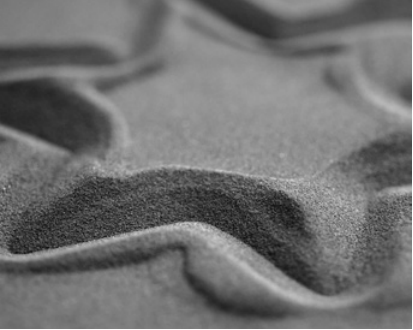
The main challenge for automobile manufacturers and first-tier manufacturers is to minimize weight and power while optimizing fuel efficiency. At the same time, the industry is also trying to optimize the supply chain to reduce operation and investment costs.
Today, benefiting from the net forming advantages and competitiveness of powder metallurgy technology, high-performance structural components made of sintered PM materials can be found in almost every modern transmission, engine, pump, steering system, body and chassis.
Cost-effectiveness, high precision and repeatability, as well as maximum material utilization, customized characteristics, design freedom and sustainability, are all the advantages of promoting PM programs.
Compaction and sintering is the process of forming powder into solid parts, first pressing and then sintering. In addition to powder, there are adhesives, antiflocculating agents and lubricants in the mixture.
powder pressing is most suitable for flat parts with two-dimensional geometry and thin thickness. The problem of increasing the complexity and thickness of the parts is that the uneven compaction of the powder particles leads to large density changes, and the defects caused by the need for spray compaction compacts.
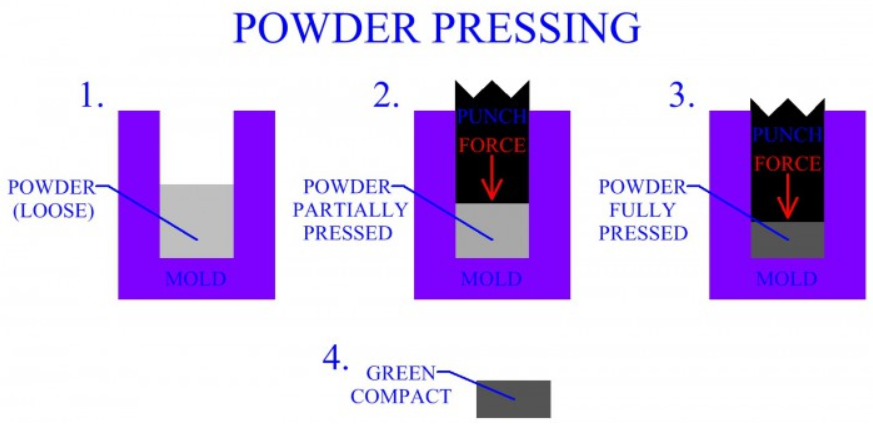
powder pressing is to press the powder into geometric shape, usually at normal temperature. This will produce a compact green. The strength of this compacted unburned component depends on the compactness, and the compactness can be enhanced by using adhesive. The green body can be disassembled with bare hands, but it is also strong enough. The geometric shape is similar to that of the final part, but the shrinkage will occur in the sintering stage of the manufacturing process, and the shrinkage must be calculated.
The powder demand is based on the bulk density of the powder and the material quantity of the final product. The bulk density is the density of the loose powder itself. When measuring the amount of powder, the bulk density is very important, and the effect of additives such as lubricants should be calculated. For example, if a green body contains a certain amount of lubricant and binder, additional materials will be added. In the sintering process, these lubricants and adhesives are burned and no longer exist in the parts, which is a factor that must be considered.
When a certain amount of powder is injected into the mold, the mold filling rate mainly depends on the fluidity of the powder. Easily flowing powder can be poured at a higher speed, and pouring can be an automatic process.
Once the mold is filled, the punch will move towards the powder, and the punch will exert pressure on the powder to compact the powder to the correct geometric shape. The stamping process is shown in the figure.
Punch and die surfaces are very important in powder manufacturing. There must be a gap between the punch and the die in order for the punch to move in the die. Powder particles may get stuck in the gap, causing problems with machine movement. To prevent this problem, the limit should be designed very low, usually less than 0.001 inch. Most punches and dies are made of hardened tool steel, and their surfaces are ground and polished in the direction of tool movement. Punches and dies for more extreme powder processing are made of tungsten carbide.
The force required for the pressing operation depends largely on the material. For example, pressing aluminum powder requires a small force, while iron powder requires a large force. The pressing force also depends on the powder properties, additives and the expected density of the green. In the process of pressing, the friction hinders the movement of particles, and the lubricant can reduce the required pressing force, making the particle distribution more uniform. Excessive lubrication will gather in the space in the particles and organize the compaction of the powder. The pressing force is a function of the pressure on the part area perpendicular to the pressing direction. Generally, the press is vertical, and the horizontal plane of the part should be considered.
The force of industrial powder manufacturing generally varies between 10000 pounds per square inch (70MPa) and 120000 pounds per square foot (800MPa). Most of these parts are small (less than 5 pounds), and the pressure requirement is generally less than 100 tons. A press with a capacity of several tons is usually suitable for most powder processing operations, while a hydraulic press with a capacity of several thousand tons is used for work requiring greater force. For more complex parts, the multi-action press can be used, and the stamping speed needs to be adjusted. Faster compaction speed can improve production efficiency, but if the speed is too high, the air will be left in the gap, preventing the parts from being compacted correctly.
The compaction of parts depends on the role of powder particles in the compaction process. When the powder is first filled into the mold, its bulk density or the density of loose powder. With the compression of the powder, its volume decreases and its density increases until it reaches the final volume and density of the green (green density). The fully pressed parts will still contain pores, and the green density will be lower than the true density of the material.
The inter-particle pore and particle surface are important factors for powder pressing. Avoid surface facial mask on powder particles. These materials, such as oxides, will be wiped off and occupy the space between particles during the compaction process, thus preventing the proper compaction of parts. In the first stage of powder pressing, the density is increased by rearranging individual powder particles. The space and gap are eliminated, and the density is increased due to the particles. This initial stage provides relatively low resistance, and the density of the powder increases rapidly with the applied pressure. With the compression process, the contact force between powder particles increases continuously. The cold pressure welding occurs at the contact point between particles, which is conducive to the structural integrity of green billets for further processing.
The second stage has no clear starting point, which is characterized by plastic deformation of particles, and the stress between the contact points of powder particles leads to material deformation. With the increase of the contact area, the particles undergo interlocking and plastic flow, the volume decreases, and the density continues to rise. The movement of materials is increasingly hindered by friction and work hardening of metal powder Unlike the first stage, the rate of density increase will decrease as the pressure continues to rise. The density will continue to increase until the maximum density of the pressed powder is reached.
Most of this space is still an interconnected pore network, mainly open pores. Relative to the applied pressure, the density of compactness varies with different processing factors. The typical relationship between pressure and compactness is shown in the figure.
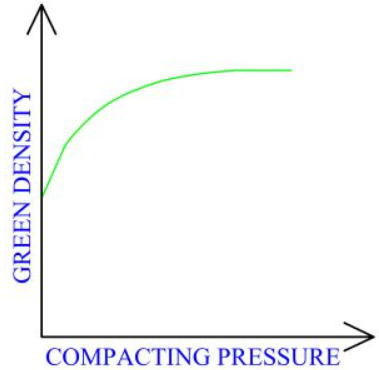
Ideally, the increase in density will occur evenly throughout the compaction process. The change of density is an important problem in powder manufacturing, mainly due to friction and geometric shape of parts, and increases with the complexity of parts. Lubrication helps reduce friction, provides more uniform flow during compaction, and takes care to avoid excessive lubrication. Another way to create a more uniform compaction is to use an additional punch with independent motion. Multi-action pressing of powder is a common method for more complex parts.
The design principle of powder pressing operation using one, two or more actions is based on the way of powder compression. Low pressure in the powder material will lead to loose compaction and low density in this area. The pressure in the powder decreases with the distance from the punch surface.
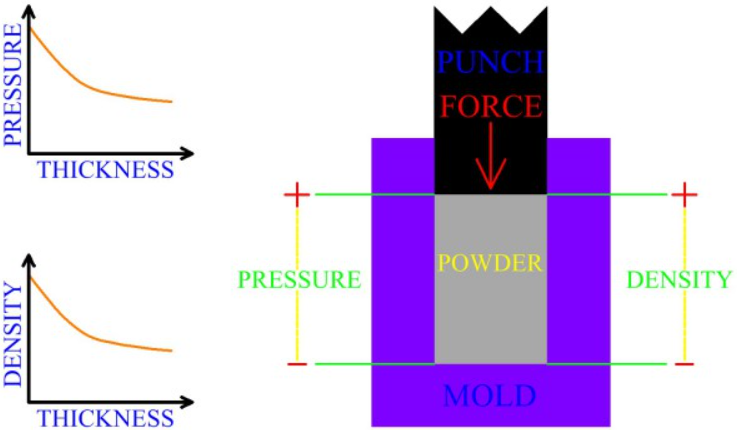
When using powder to make thin parts (high diameter to thickness ratio), problems may not occur. For thicker parts, the distance from the punch may change significantly in density. In order to alleviate the problem of density-pressure change in this compacted powder, two opposite punches are usually used.
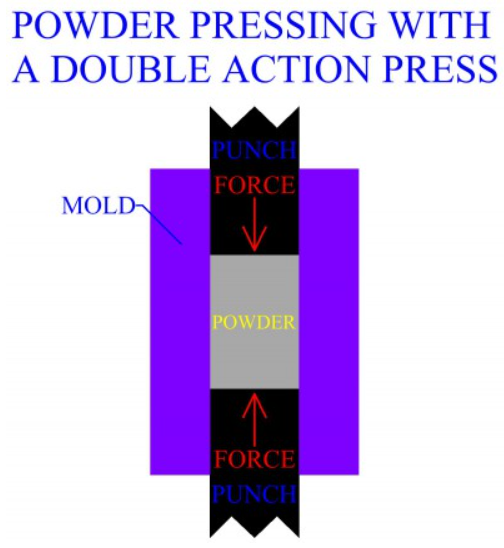
Powder sintering refers to raising the temperature of green billet to a certain level and maintaining it at this temperature for a period of time. The sintering temperature is usually between 70% and 90% of the melting point of the powder metal, which causes the powder particles in the compact to bond. The pressed unburned parts usually have structural integrity, and the bonding during sintering enhances the strength of the parts.
In the sintering process, the single particle structure disappears and the material forms a block. Conventional sintering will further reduce porosity. In addition to volume reduction, sintering will separate the interconnected pores in the green. These separate areas become closed pores because they are cut off from the external environment. Sintering is characterized by burning out the additives in the powder, which are used in the early processing stage. Eliminating unwanted ingredients, such as lubricants, adhesives and deflocculating agents, is essential to maintain the purity of the final product material. In addition to increasing the strength and density of parts, sintering also increases the ductility, thermal conductivity and conductivity.
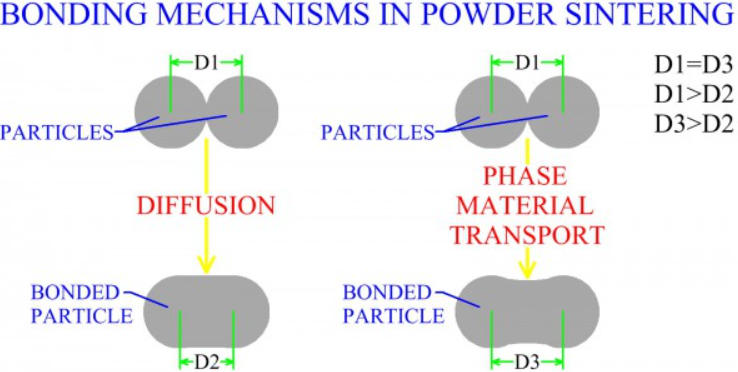
The mechanism of adhesion in sintering process is diverse and complex. The main mechanism of adhesion is considered to be diffusion, and the mechanism will change according to manufacturing process factors and powder properties.
The bonding mechanism in the sintering process is complex and different, but the main driving force of the particle bonding is considered to be the reduced energy due to the reduction of surface area. The powder with larger surface area will have higher adhesion driving force and lower this potential energy.
Alloying of different metal powders also occurs during sintering. The sintering temperature must always be lower than the melting temperature of at least one powder component. In some cases, the sintering temperature is higher than the melting point of one material but lower than the melting point of the other, which is called liquid phase sintering. Liquid phase sintering can eliminate porosity and produce parts with excellent material properties.
The main variables of powder sintering are time, temperature and furnace atmosphere. The sintering temperature is usually 0.7 to 0.9 of the powder melting point. The sintering time depends on the manufacturing process factors and materials. For example, the sintering time of tungsten is relatively long. Standard industrial powder sintering time for different processes and materials varies from 8 minutes to 10 hours.
In the process of powder sintering, the controlled atmosphere is very important. The purpose of atmosphere in sintering process is to control carburization and decarburization, prevent oxidation and remove existing oxides, prevent unnecessary chemical reactions, and assist in burning additives. Common atmospheres used for industrial powder processing are carbon monoxide, dissociated ammonia, hydrogen, partially burned natural gas and inert gases, such as argon or helium. Sometimes parts are also sintered in vacuum. Vacuum sintering is mainly applicable to refractory metals and stainless steel.
The sintering of raw meal pressing is carried out in three stages. First of all, the powder tablet should be preheated. Preheating will raise the component to a relatively low temperature and make the additive burn off. Preheating will also begin to strengthen the integration within the components and increase their integrity for the next stage. In the second stage, the temperature is raised to the sintering temperature and kept for a certain time to reach the required binding amount. In the third stage, when the parts are allowed to cool down, the temperature will decrease. During the cooling process, keeping the workpiece in a controlled furnace atmosphere is essential to prevent unnecessary chemical reaction between the workpiece and the environment.
In industrial powder manufacturing, there are two types of furnaces, batch furnace and continuous furnace. In the batch furnace, a small number of parts are put into the furnace, undergo the whole sintering process, and then taken out. The continuous furnace provides flow production and has three areas for the three stages of the manufacturing process (preheating, sintering and cooling). A moving belt carries continuous parts supply through the furnace. Hot parts can be quickly opened and closed, allowing parts to pass while maintaining heat. The belt travels at an accurate speed so that the parts have an accurate time in each chamber. Stable products and high productivity make continuous furnace the most common choice for powder sintering. Although batch operation furnaces have low productivity and less use, they do provide more control over the atmosphere, thus improving the purity of parts. Vacuum atmosphere can only be provided by batch furnace.
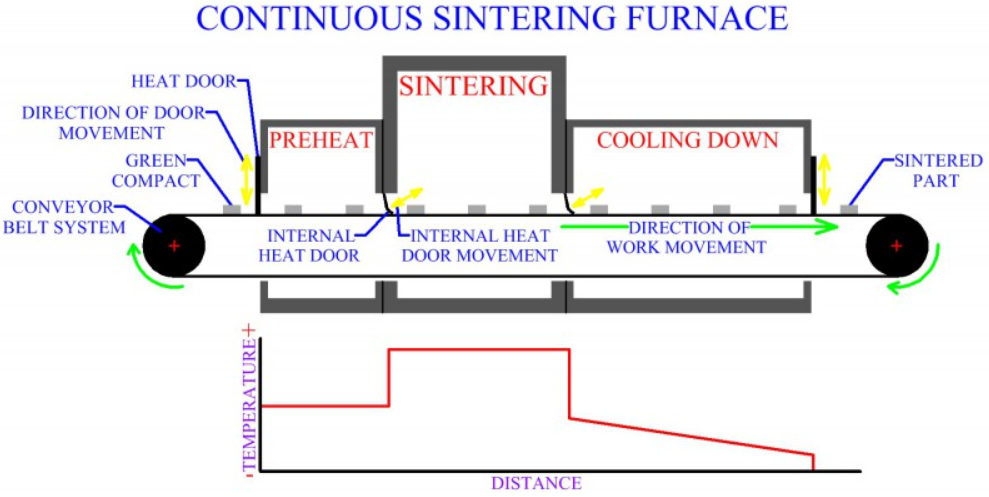
Porosity is a characteristic of powder processing materials. In some cases, the goal is to reduce or eliminate porosity. In other cases, a certain degree of porosity is required. As mentioned above, porosity exists in green. The porosity in raw meal tabletting can be controlled to a certain extent by the pressure level of tabletting. If the compacted material is not fully compacted, there will be more porosity than when it is fully compacted. In fact, in loose sintering, the powder is not compacted at all. For special parts such as metal filters, very high porosity can be achieved.
The measurement of porosity in metals is usually quantified as the percentage of voids in the material. Less than 10% is low porosity, 10% - 20% is medium porosity, and more than 25% is considered as high porosity material. The pores in the pressed green tablet are mostly interconnected pores, and the pore network is open to the external environment. During sintering, the volume of pores decreases, and many pores are isolated from the main pore network and external environment. When pores are isolated in the material, they are no longer considered as open pores, but closed pores.
Impregnation is the filling of pores in metal with liquid. A common application in this area is the production of self-lubricating components, such as bearings and gears. In these cases, powder processed parts are usually soaked in hot oil. Parts are usually impregnated with 10% - 30% oil by volume. Sometimes, parts will be impregnated with polymer resin to prevent other substances from entering the pores or to assist in further processing.
Infiltration is the filling of metal pores with another metal whose melting point is lower than the base material. The penetrating metal is heated to a temperature higher than its melting point but lower than the porous metal part. Liquid metal is allowed to enter the porous network and solidify, filling the pores with solid metal. Infiltration can produce components with special mechanical properties. Iron infiltrated into copper is a common example of this process in manufacturing.
As mentioned earlier, pores may become isolated during powder processing. The number of interconnected, open (independent) pores is a key factor in impregnation and infiltration. The material cannot enter the pores isolated from the external environment. The number of open pores can be measured by the amount of liquid required to saturate the part.
Like most other major manufacturing processes, powder metallurgy often requires further processing of products. The porosity of parts manufactured by powder method is a special factor for secondary processing or finishing of such parts.
The combination of powder metallurgy and forging can produce high quality parts. The parts made of powder have a porosity of about 15% - 20%, and then are hot forged. Generally, forging is flameless. Hot forging eliminates pores and improves the density of parts. The hot forging of powder machined parts can also form uniform forged grain structure. The mechanical properties of the parts can be greatly enhanced by forging the parts made of powder for secondary processing. Since powder forming processes the parts into a shape close to the net weight, forging usually requires only one step. Other metal forming processes, such as rolling and extrusion, can also be used as secondary processing of pressed and sintered parts. These processes can also be cold or hot.
In industrial manufacturing practice, it is very common to process parts produced by powder metallurgy. Machining is usually not used to remove large pieces of material, but for fine processing. Some specific part features, such as side holes, cannot be produced by powder processing. Features that are not produced during the pressing and sintering of parts can be produced by machining. A common problem of powder processing parts is that the coolant and lubricating fluid used in the processing process produce unnecessary impregnation on the porous structure of parts. To solve this problem, we have adopted some technologies, such as dry processing and infiltration (or impregnation) with other materials.
Sizing and embossing are common finishing operations. Gluing is sometimes used for parts manufactured by powder process to form their final dimensions. Sizing only involves a small but precise geometric change of the workpiece. Although sizing can be used to improve geometric accuracy, stamping can be used to improve surface finish and add details for powder processed parts.
The powder processing products can be heat treated on the premise that the porosity of the workpiece is calculated as a factor in the manufacturing process. The increase of porosity will reduce the thermal conductivity of metal parts, resulting in slower heating and cooling rates than other conditions.
Surface processes such as painting or electroplating are also used for finishing of powder processed products. As with other secondary processing and finishing, the porosity of the work must be considered. Materials used for surface coating should not be absorbed into the porous structure of the workpiece. The surface treatment is usually carried out by infiltration and impregnation of porous parts.
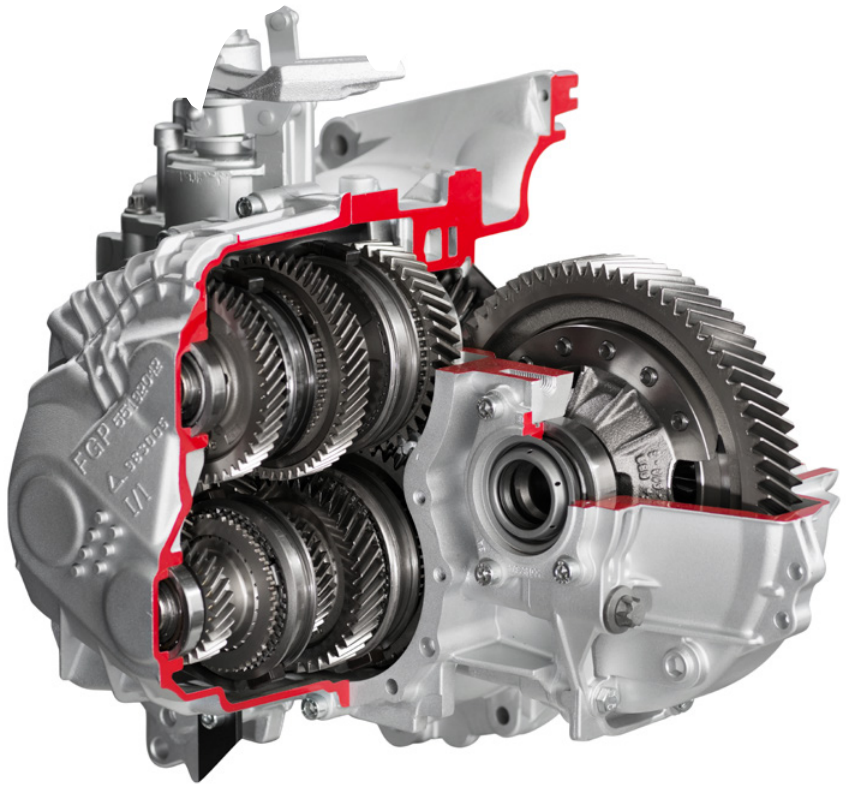
BRM is a global leader in the application of innovative powder metallurgy materials and the promotion of the powder metallurgy market. Based on the new design method and advanced manufacturing technology, we can provide and design many parts in the automobile industry.
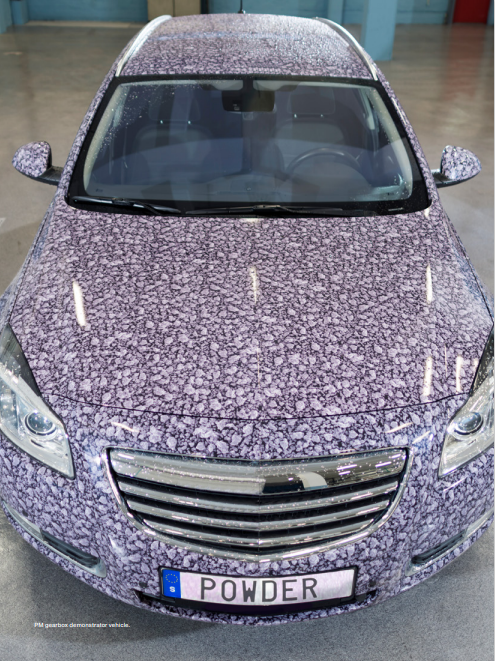
The new gear solution can not only meet the performance and service life requirements of OEM, but also greatly shorten the traditional gear manufacturing supply chain. Due to the advantages of net forming, PM gear technology reduces most machining processes and significantly reduces manufacturing costs.
At the same time, it can also achieve some technical advantages, such as reducing the weight and inertia of the gear, integrating additional practical functions, optimizing the tooth root shape of the gear to reduce structural vibration, thus reducing gear noise.
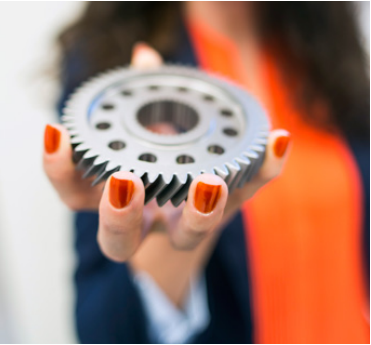
It minimizes the floor area of the factory, greatly reduces the use of processing fluid, and generally reduces energy consumption. PM gear technology can reduce weight, improve fuel efficiency and reduce carbon emissions. It is a highly sustainable and efficient gear manufacturing technology.
In order to prove the application of PM gear technology in modern automobile transmission and show its full potential, the prototype design of the world's first six-speed manual transmission has been completed and tested, and the vehicle has traveled thousands of miles.
The success of PM gear technology requires an understanding of micro-geometry requirements and system design capabilities. Our rich fatigue test data of gear materials is the perfect basis for this aspect.
Trust professional knowledge leaders
Through the understanding and performance requirements of modern transmission, our professional team can analyze the gear load, optimize the macro and micro design requirements of components, and find the most suitable manufacturing process and materials. Open up new business opportunities through PM gear technology.
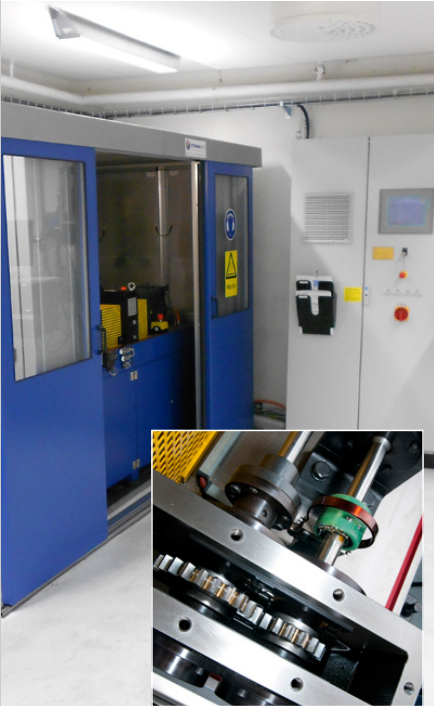
Small weight and inertia of PM gear
Based on the design freedom of PM and the design analysis of gear, only the weight is added where the function is required. In some cases, the weight reduction design function can be added to realize the weight reduction hole without additional cost.
Reliable material data
BRM has carried out a lot of experiments, including contact stress, tooth root bending and contact fatigue, to meet the requirements of working life and maximize the material performance.
High-performance PM materials meeting quality requirements and cleaning standards
As a leader in the powder industry, we constantly break through the performance limits of materials and manufacturing processes. The stable process, mass production and quality control ensure the high quality powder that can be reused and realize the high level performance of the material.
Optimize gear stress and transmission error
When using powder metallurgy materials, it is necessary to design through micro and macro geometric scales. The simple template of the existing gear cannot optimize the performance and noise of the gear. We can help modify the side and micro geometry of the gear to achieve better results.
Reduce vibration and gear noise
With the improvement of hybrid and electrification of modern transmission system. Higher internal damping and increased energy dissipation are beneficial to the powder metal gear structure. PM gear has less noise than forged steel gear. The use of PM gear technology can improve shift noise, impact noise and NVH performance.
One-stop PM gear development and prototype design partner
BRM combines its own capabilities, product innovation and customer service with the world's leading technical partners in system design, gear processing, PM tool manufacturing, PM pressure solutions, surface densification technology, heat treatment, etc.
Proper heat treatment process
Select proper heat treatment process through PM to ensure the best performance of PM gear. The heat treatment of PM is different from that of forged steel and is not difficult. A tailored shell profile and the compressive stress under the surface are very important for maximizing product performance.
PM gear is more sustainable
Due to the advantages of net forming, steel raw material recovery, lower energy input, higher material utilization rate, reduced processing operations, reduced waste, etc. PM gear technology minimizes the impact on the environment, society and economy.
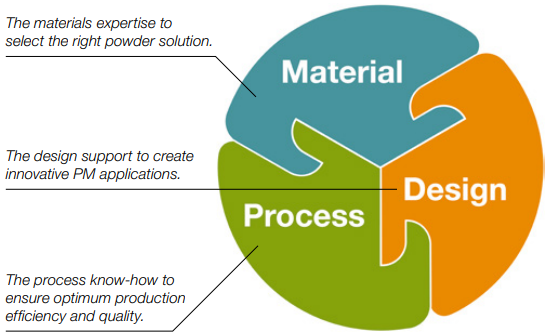
At the POP center, BRM develops new PM applications and infrastructure. Here, BRM experts and technical partners provide professional material knowledge and customer service.
Powder technology can create a world full of opportunities. The inherent characteristics of metal powder provide unique possibilities for customized solutions to meet various requirements. Our goal is to continuously expand the application range of metal powder, which is the power of powder. With our leading position in metal powder technology, BRM is fully capable of helping you seize these opportunities.
Contact: Cindy Wang
Phone: +86 19916725892
Tel: 0512-55128901
Email: [email protected]
Add: No.6 Huxiang Road, Kunshan development Zone, JiangsuShanghai Branch: No. 398 Guiyang Rd, Yangpu District, Shanghai, China